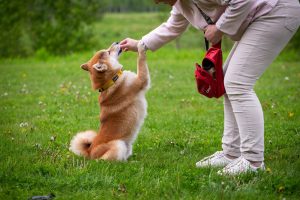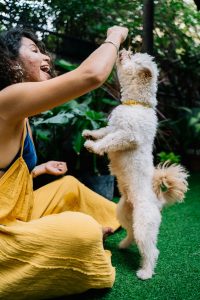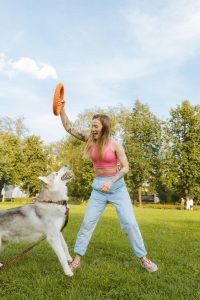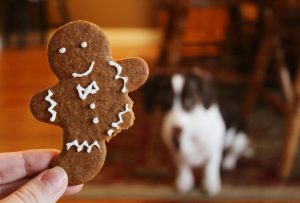Recently I came across an article about pattern games. And of course, whenever I came across something new and interesting regarding dog training, I always try it on Milo. And what do you know, it works.
So, let’s talk a bit more about what are pattern games and how they work. Pattern Games are a set of simple exercises that provide a predictable and secure structure for dogs. They are designed to help your puppy normalize changes in the environment. For example, potential triggers for reactive dogs.
Being that I am a huge fan of structured walk, I had to give it a try. The simple way to explain is pattern games set the dogs up to make good behavioral choices and teach them to focus and work comfortably around things that excite them.
The concept works perfectly when you want to train with an overly excited dog.
Why try pattern games?
What I have found out is that these games help teach your dog to focus and get back to you when there are sudden environmental changes. For example, a squirrel appears. Or someone throws a ball. Think of any distraction or trigger that can happen. When you teach them, this is what happens:
- Pattern games provide a predictable and secure structure
- They help normalize changes in the environment
- They provide fun for your puppy
Understanding the nitty-gritty
Now let’s dive a bit more into what exactly are pattern games. They first appeared in a book by Leslie McDevitt. Her control unleashed program is great.
Now, by pattern, we describe a series of repetitive things that are predictable and reliable. For example, if you know your dog will be exposed to a distraction, something that will excite or upset your dog, you work on that particular moment. It is easier for your dog to recover from that and keep focusing on whatever you are doing.
When your dog operates within a structure, it knows exactly what follows and what will happen next. And he is getting ready for that next step, no matter the distractions around.
And the best part is, that you can do this structure at any point in time. You are basically giving your dog three to four repeating things over and over. And I assume you might be doing some of it already. For example, throw a ball, a dog retrieves it, and throw it again.
The best part is that the dogs can be put in control of the patterns. And that gives you feedback on whether your dog is engaged or is bored.
You put the rules and structure in place, and the dog controls the game. Of course, the rules stay the same even as other aspects change.
Why are these games great?
So, what makes these games so successful? They sound simple, but what makes them great? Well, a huge part is the predictability. Your dog knows what happens next, but it is not bored by it. It is called structure.
This happens, then this happens, and then this happens. And these rules work like a charm with a reactive dog. The more your reactive dog knows, the more feedback he has, and the easier it is for him to predict what will happen next. And he will be less reactive in the end.
Most dogs are reactive because of questioning. They are unsure about the environment. You put structure into the walk, and your dog now becomes a happy puppy that enjoys your walks.
You have a pattern, and you move your dog through the space within the pattern.
Best pattern games
Now let’s take a look at a few games you can try. Personally, I have tried a few with Milo but didn’t have the time yet to try them all. But I am sure they will all work, since the ones I tried, Up and Down, worked perfectly. To be honest, we were already doing a version of up and down.
I am also sure you might probably doing some of these games but you do not know they are part of a pattern.
Scatter
This game helps your dog sniff and eat food and function normally in the environment. When your dog functions normally, they can sniff around and they are at an emotional state where you can for something more. A dog who is calm and sniffs around is also better at communicating with other dogs.
- Start by tossing some treats onto the ground in a scattered formation. This will allow the dog to sniff and eat food
- Then, add a phrase like find it and toss another round of treats onto the ground. Point to the ground if needed to
You can use this game to acclimatize your dog to a new environment when he is overly excited. Or as a training exercise intermission.
Up and Down
This is probably my favorite game because it helps with so many things. For one, it helps with impulse control and getting the focus instantly at you.
- Put a treat on the ground and wait until your dog eats it and looks up at you
- When your dog looks at you, he is basically asking for more treats. Me and Milo played a version of this game for impulse control and teaching patience
- Repeat until you want. The game is great when you wait in line, so that dog is always looking at you. Or you can use it for practicing heel. Or when a dog is anxious about a situation happening, like another dog approaching you.
1-2-3
This is another great game that you can use while walking. It is similar to the up and down, but you are now walking. It helps your dog stabilize itself and process the environment by focusing on you, and not the distractions around. Same as the previous game, you can try it while walking and practicing heel.
- Count out loud 1-2-3, and on 3, place a treat in front of your dog. Or you can give the treat to your puppy
- Wait with your dog as your puppy is eating the treat. Then, repeat the pattern
- The verbal pattern adds predictability to this exercise and makes your dog focused on you while walking
You can use the game when you need to move from one spot to another without paying attention to distractions.
Ping Pong
The game got its name after the popular sport. It will help you teach your dog to focus and reorient back to you. You can also turn it to chase food game from one side to another when there is a sudden environmental change.
The pattern will help your puppy stabilize and process the environment around. It is soothing and brings exciting behavior or stressed behavior back to normal behavior.
- Sit in a chair and roll a treat on the floor to your right
- After your dog eats the treat and turns back to you, mark the behavior, and roll a treat to the left
- Keep repeating until your puppy masters the game
- Take things up a notch. Roll a treat, wait for your dog to eat it, then come to you, establish eye contact, and then roll a treat to the other side
- When your dog masters that part, stand instead of sitting. Then, start moving away and roll the treats to the left or to the right. You can do the same game with a ball if your dog is toy-driven
Two Cookie
We finish off with the game called two cookie. It is a pattern done by feeding from your hands. You can also do it from the ground, but I prefer from the hands. Your dog is in a back and forth motion and you can modify the pace for your dog.
It will help your dog process the environment and get into calm behavior. Once you establish a pattern, you can add a distraction to take things to the next level.
- Put treats in both hands
- Feed from one hand and then from the other
- Wait for your puppy to make eye contact before feeding
- The small movement from left to right is what makes this game different from the up and down game







2 Responses
Your blog has become my virtual escape when I’m in need of inspiration.
I appreciate how you curate a diverse range of content,
from adventure travel to cultural experiences to food exploration.
Thank you for sharing!
We are happy you feel that way